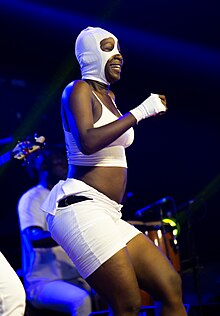Congolese dance music genre
| Ndombolo |
|---|
 A woman dances ndombolo in 2023 |
| Stylistic origins | Soukous |
|---|
| Cultural origins | 1990s |
|---|
| Typical instruments | Guitar, drum |
|---|
|
| Kenya, Rwanda, Madagascar, Tanzania, Cameroon, Ivory Coast, Rwanda, Burundi, Uganda, Republic of the Congo, Senegal, Nigeria, Angola, Togo, Niger, Central African Republic, Gabon |
|
| Music of the Democratic Republic of the Congo |
Ndombolo, also known as dombolo, is a genre of dance music originating in the Democratic Republic of the Congo.[1][2][3][4] Derived from soukous in the 1990s, with fast-paced hip-swaying dance rhythms, often accompanied by upbeat, percussion-driven music, the style became widespread in the mid-1990s and the subsequent decade, dominating dancefloors in central, eastern, and western Africa. It inspired West African popular music, coupé-décalé, Kuduro, and East African dance music.[5][1][4][6][7][8]
Ndombolo customarily features lead vocalists, backup vocalists, guitars, drums, and synthesized sounds.[9] The lyrics often explore themes of human relations, marriage, courtship, trickery, disappointment, and Congolese sociopolitical culture.[10][11][12] Prominent musicians such as Papa Wemba, Dany Engobo, Koffi Olomide, Werrason, Awilo Longomba, Quartier Latin International, Général Defao, Aurlus Mabélé, Extra Musica, Wenge Musica, and Wenge Musica Maison Mère played a pivotal role in popularizing the genre.[12][13][14][15][16]
- ^ a b Tchakam, Stéphane (2 December 2003). "Cameroun : L'autre danse congolaise". Cameroon Tribune (in French). Retrieved 8 November 2023.
- ^ White, Bob W. (1999). "Modernity's Trickster: "Dipping" and "Throwing" in Congolese Popular Dance Music". Research in African Literatures. 30 (4): 156–175. ISSN 0034-5210. JSTOR 3820759.
- ^ Knights, Vanessa (29 April 2016). Music, National Identity and the Politics of Location: Between the Global and the Local. Thames, Oxfordshire United Kingdom: Routledge. p. 208. ISBN 978-1-317-09160-8.
- ^ a b Otiso, Kefa M. (24 January 2013). Culture and Customs of Tanzania. New York City, New York State, United States: Bloomsbury Publishing USA. ISBN 979-8-216-06991-1.
- ^ Falt-Brown, Amaury (12 March 2020). "Afrobeats: The meteoric rise of a misnomer". Music in Africa. Retrieved 12 May 2024.
- ^ Sobania, Neal W. (30 June 2003). Culture and Customs of Kenya. Santa Barbara, California, United States: Bloomsbury Publishing USA. pp. 207–208. ISBN 978-0-313-03936-2.
- ^ AfroConex (9 March 2023). "Spreading Ndombolo Dance Across Africa with Bush Sebar". AfroConex. Retrieved 8 November 2023.
- ^ Kabwe, Jason (15 March 2013). "Ndombolo Craze". Czech Radio (in Czech). Retrieved 9 November 2023.
- ^ Falola, Toyin; Jean-Jacques, Daniel (14 December 2015). Africa [3 volumes]: An Encyclopedia of Culture and Society [3 volumes]. Santa Barbara, California, United States: ABC-CLIO. p. 627. ISBN 978-1-59884-666-9.
- ^ Education, Pan African Society for Musical Arts (2005). Emerging Solutions for Musical Arts Education in Africa. Cape Town, South Africa: African Minds. pp. 333–334. ISBN 978-1-920051-11-2.
- ^ Kuoni, Carin; Haines, Chelsea (22 January 2016). Entry Points: The Vera List Center Field Guide on Art and Social Justice No. 1. Durham, North Carolina, United States: Duke University Press. ISBN 978-0-8223-7395-7.
- ^ a b Anheier, Helmut K.; Isar, Yudhishthir Raj (31 March 2012). Cultures and Globalization: Cities, Cultural Policy and Governance. Thousand Oaks, California, United States: SAGE. p. 174. ISBN 978-1-4462-9172-6.
- ^ Heidenreich-Seleme, Lien; O'Toole, Sean (2012). Über(w)unden: Art in Troubled Times. Johannesburg, South Africa: Jacana Media. p. 66. ISBN 978-1-4314-0497-1.
- ^ Falola, Toyin; Jean-Jacques, Daniel (14 December 2015). Africa [3 volumes]: An Encyclopedia of Culture and Society [3 volumes]. London, England: Bloomsbury Publishing USA. ISBN 979-8-216-04273-0.
- ^ Ndi-Shang, Gil (3 April 2021). The Radio and Other Stories. Spears Media Press. p. 15.
- ^ Seck, Nago (31 August 2007). "Ndombolo". Afrisson (in French). Retrieved 12 November 2023.

